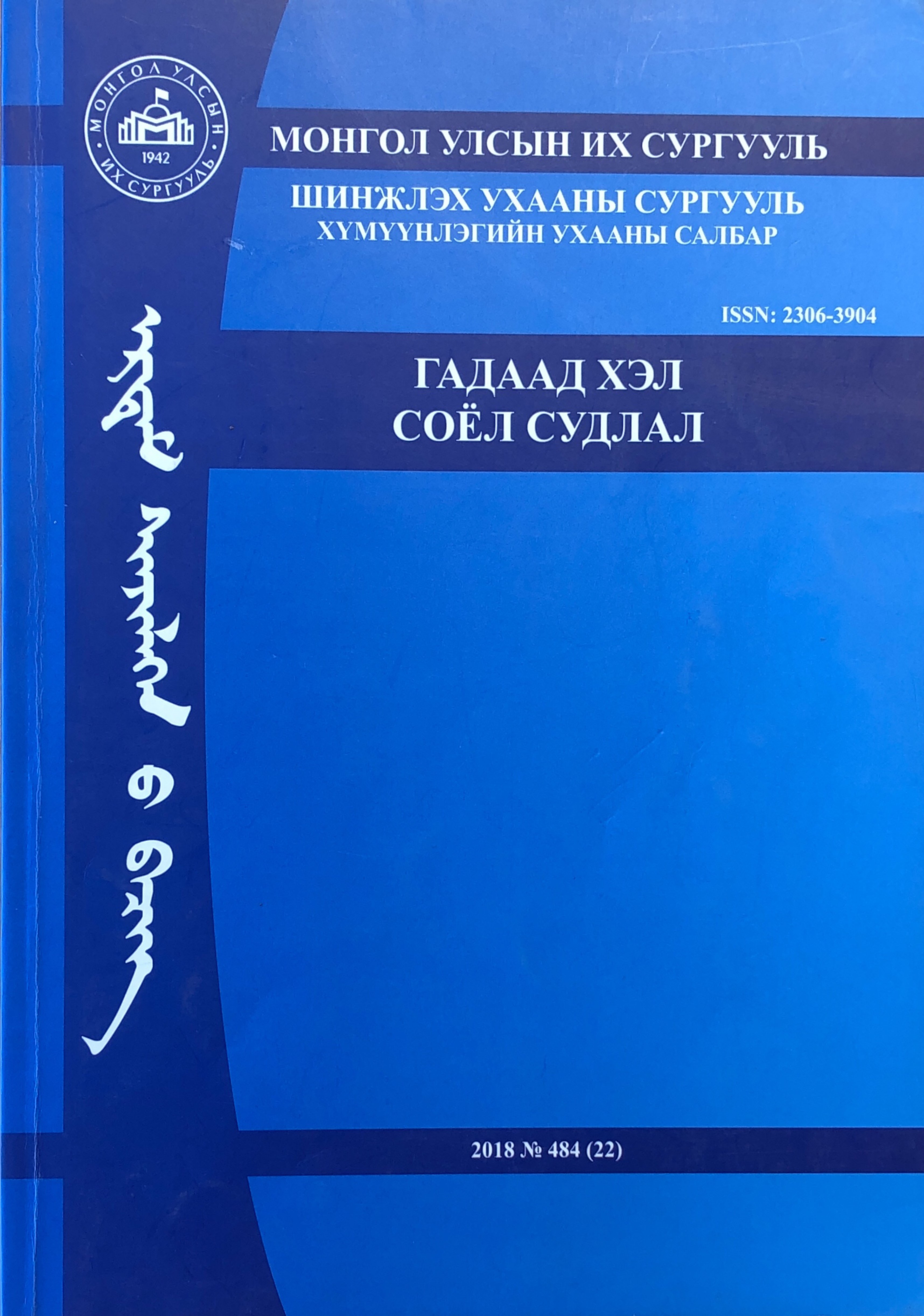A Critical Review of the Two-component Theory of Aspect
Байдлын хоёр бүрэлдэхүүнт онолыг шүүмжлэн хэлэлцэхүй
DOI:
https://doi.org/10.22353/MJFLC2018103Keywords:
aspect, Aktionsart, two-component theory, viewpoint, situation type, perfective, imperfective, neutralAbstract
Энэхүү шүүмж өгүүлэлд Америкийн хэл шинжлэлч Карлота С.Смитийн дэвшүүлсэн Байдлын хоёр бүрэлдэхүүнт онолыг (Two-component theory of aspect) авч хэлэлцлээ. Байдлын хоёр бүрэлдэхүүнт онолд өгүүлбэрийн байдлын утга нь тухайн өгүүлбэрийн илэрхийлж буй “үйлийн төрөл” (situation types) болон өгүүлэгчийн үйлийг “харах өнцөг” (viewpoint) хоёрын харилцан зохицол гэж үздэг. Үйлийн төрөл нь өгүүлбэрийн үндсэн үйл үг, түүний гадаад, дотоод аргументуудаар илрэх тул утга зүйн айд, харин харах өнцөг нь нөхцөл, задлаг бүтэц зэргээр илрэх тул хэл зүйн айд тус тус хамаарах үзэгдлүүд юм. Үйлийг хөдлөнгө эсэх (dynamicity), үргэлжлэх эсэх (durativity), дотоод хязгаартай эсэх (telicity) гэсэн гурван шалгуурыг харгалзан тогтонги төлөв (state), үйл явц (activity), биелэлт (accomplishment), төгсөл (achievement), агшин зуурын үйл (semelfactive) гэсэн таван төрөлд хувааж болох бол, харин харах цэг нь Төгс (perfective), Төгс бус (imperfective), Тодорхой бус (neutral) гэсэн гурван янз байна. Эдгээрийн харилцан зохицол хэл болгонд өөр өөр байдаг. Жишээлбэл, Англи хэлэнд тогтонги төлөв төгс бус байдалтай зохицдоггүй бол, монгол хэлэнд зохицдог. Өгүүллийн төгсгөлд зохиогч Байдлын хоёр бүрэлдэхүүнт онолын учир дутагдалтай талыг дурдаж, уг онолыг боловсронгуй болгох талаар санал бодлоо дэвшүүллээ.
References
Agrell, S. (1908). Aspektänderung und Aktionsartbildung beim Polnischen Zeitworte. Lund: H. Ohlsson.
Bache, C. (1982). Aspect and Aktionsart: Towards a semantic distinction. Journal of Linguistics, 18,
-72.
Binnick, R.I. (1991). Time and the verb: A guide to tense and aspect. New York: Oxford University Press.
Carlson, L. (1981). Aspect and quantification. In P.Tedeschi & A.Zaenen (Eds.), Syntax and Semantics. Vol 14. Tense and aspect (pp.31-64). New York: Academic Press.
Curtius, G. (1846). Die Bildung der Tempora und Modi im Griechischen und Lateinischen sprachvergleichend dargestellt. Berlin: Wilhelm Besser.
Dahl, Ö. (1985). Tense and aspect systems. Oxford: Basil Blackwell.
Declerck, R. (2007). Distinguishing between the aspectual categories (a)telic, (im)perfective and (non)bounded. Kansas Working Papers in Linguistics, 29, 48-64.
Depraetere, I. (1995). On the necessity of distinguishing between (un)boundedness and (a)telicity.
Linguistics and Philosophy, 18, 1-19.
Dik, S. (1997). The theory of functional grammar.Vol .1: The structure of the clause (2nd ed.). Berlin/New York: Mouton de Gruyter.
Dowty, D. (1979). Word meaning and Montague grammar. The semantics of verbs and times in generative semantics and in Montague’s PTQ. Dordrecht: Reidel.
Filip, H. (1999). Aspect, eventuality types, and nominal reference. New York: Garland.
Friedrich, P. (1974). On aspect theory and Homeric aspect. International Journal of American Linguistics, 40(4-2), 1-44.
Hermann, E. (1927). Objektive und subjective Aktionsart. IF, 45, 207-28.
Holisky, D. (1981). Aspect theory and Georgian aspect. In P.Tedeschi & A.Zaenan (Eds.), Tense and aspect: Syntax and semantics, 14(pp. 127-143). New York: Academic Press.
Holt, J. (1943). Études d’aspect. Acta Jutlandica, 15(2), 1-84.
Hopper, P. (1982). Aspect between discourse and grammar: An introductory essay for this volume. In P.Hopper (Ed.), Tense and aspect: Between semantics and pragmatics (pp.3-18). Amsterdam/Philadelphia: John Benjamins.
Jakobson, R. (1971). Shifters, verbal categories, and the Russian verb. The Hague/Paris: Mouton.
Klein, W., Li, P., & Hendriks, H. (2000). Aspect and assertion in Mandarin Chinese. Natural Language and Linguistic Theory, 18, 723-70.
Lyons, J. (1977). Semantics. Vol 2. Cambridge: Cambridge University Press.
Macaulay, R.K.S. (1978). Review, Comrie (1976). Language, 54, 416-20.
Moens, M. (1987). Tense, aspect, and temporal reference. (Doctoral dissertation, University of Edinburgh, Edinburgh, UK).
Mourelatos, A. (1981). Events, processes, and states. In P.Tedeschi & A.Zaenan (Eds.), Tense and aspect: Syntax and semantics, 14 (pp. 191-212). New York: Academic Press. (Original work published in Linguistics and Philosophy, 2, 1978: 415-34).
Németh, B. (2011). Az aspektus a magyar nyelvben, különös tekintettel a statikusságra [Aspect in Hungarian, with special emphasis on stativity]. (Doctoral dissertation, Babeş-Bolyai University, Cluj- Napoca, Romania). 24. Olsen, M. (1997). A semantic and pragmatic model of lexical and grammatical aspect. New York: Garland.
Porzig, W. (1927). Zur Aktionsart indogermanischer Präsensbildungen. IF, 4, 152-67.
Sasse, H.-J. (2002). Recent activity in the theory of aspect: Accomplishments, achievements, or just non-progressive state? Linguistic Typology, 6, 199-271.
Smith, C. (1983). A theory of aspectual choice. Language, 59, 479-501.
Smith, C. (1986). A speaker-based approach to aspect. Linguistics and Philosophy, 9, 97-115.
Smith, C. (1997). The parameter of aspect (2nd ed.). Dordrecht: Kluwer.
de Swart, H. (2000). Tense, aspect and coercion in a cross-linguistic perspective. In M.Butt & T.Holloway King (Eds.), Proceedings of the Berkeley Formal Grammar Conference. (Retrieved from https://web.stanford.edu/group/cslipublications/cslipublications/LFG/5/bfg00/bfg00deswart.pdf)
Tatevosov, S. (2002). The parameter of actionality. Linguistic typology, 6, 317-401.
Tenny, C. (1994). Aspectual roles and the syntax-semantics interface. Dordrecht: Kluwer.
Vendler, Z. (1967). Verbs and times. In Z.Vendler (Ed.), Linguistics in philosophy (pp.97-121). Ithaca, NY: Cornell University Press. (Appeared previously as Vendler, Z. (1957). Verbs and times. The Philosophical Review, 16, 143-60.)
Yang, S. (1995). The aspectual system of Chinese. (Doctoral dissertation, University of Victoria, Victoria, Canada).
Verkuyl, H. J. (1972). On the compositional nature of the aspects. Reidel: Dordrecht.
Verkuyl, H. J. (1989). Aspectual classes and aspectual composition. Linguistics and Philosophy, 12, 39-94.
Xiao, R., & McEnery, A. (2004). Aspect in Mandarin Chinese. A corpus-based study.
Amsterdam/Philadelphia: John Benjamins.
Zhang, L. (1995). A contrastive study of aspectuality in German, English and Chinese. New York: Peter Lang.





